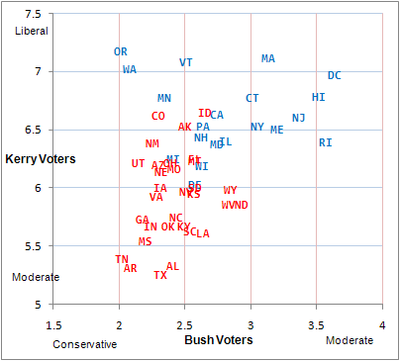Oregon and Washington are the most politically polarized states in the nation. Check out this chart from the statistics whiz kids at Fivethirtyeight:

Chart interpretation: The higher your state, the more liberal its John Kerry voters were; the further left your state is, the more conservative your George W Bush (2004) voters were. (Don’t get hung up on the colors: those just represent which candidate won the state.) Now see where Oregon and Washington are, all by their lonesome up there?
No other place compares to the Northwest when it comes to political polarization. Northwest Kerry voters were more liberal than in almost any other state; and Northwest Bush voters were more conservative than in almost any other states. Our liberals are really liberal and our conservatives are really conservative. So this explains why state politics are so much fun! (And why being governor must be a nightmare.)
Of course, this stark polarization is pretty obvious to anyone who lives here—and especially if you spend any time traveling back and forth between the west and east sides of the states. The Cascade Curtain isn’t just about geography: it also marks a deep cultural and political divide. So while I wasn’t in the least suprised, I thought it was interesting to see some empirical evidence of a Northwest peculiarity.
One complaint, however: This chart annoys the heck out of me. It would be far more intuitive if the x-axis were reversed. Moderate voters should converge in the bottom left corner and the more extreme voters should be located in the upper right corner.
Update: Clark correctly points out that without seeing the underlying data distribution, it’s tough to know if the phenomenon is actually “polarization” as we normally think of it (meaning two or more discrete “lumps” of opinion on the extremes with a smaller number of people in the center). It’s possible, for instance, that there’s just a single pole with an exceptionally large standard deviation, perhaps indicating a great diversity of political opinion. Still, I think that outside of stats class, poetic license permits use of the word “polarization.” And however you slice it, it’s true that Northwest partisans tend to share less in common with their opposition than in other states.




Matt the Engineer
I love this chart. I can find a dozen things wrong with it (the x and y scales are confusing, the fact that each liberal is a “10” and each conservative a “0” regardless of where they land on the scale, etc.), but it does seem to get at a lot of useful information at once.For others that are wondering what the scale means: Exit polls from 2004 contain a basic question about the ideology (conservative/liberal/moderate) of each voter. We can apply a Likert scale to these responses, assigning 10 points to every liberal, 5 to every moderate, and 0 to every conservative. We will call this result a Liberalness Score. (original post)
Eric de Place
Thanks, Matt! I probably should have included that stuff in the original post.
Clark Williams-Derry
On the one hand, this chart might simply show a diversity of political opinion: a roughly bell-shaped curve with a wide standard deviation.On the other hand, there aren’t many places that have the geographic & population characteristics of Oregon & Washington. They’ve got dense coastal metropolises on one side of the mountains, and dry, more sparsely populated interiors on the other side. Sort of like grafting Oklahoma onto Massachusetts. So there’s a real chance that the political distribution is actually bimodal.So…I’d be very interested in seeing more data, to find out if the political distribution is like a 2-hump camel—or if it’s simply a “purple” state: lots of political diversity united by a broad middle of shared political values.
Gary Walter
Very interesting. Anecdotally speaking, I found my last place of residence to be far worse than the NW. Recently, we lived in Colorado Springs, home of James Dobson, et al. We found the Springs to be very polarized – but that was only 500k ppl out of a state of 4 million. Oregon, my home state and now my residence too, is not so much of a battleground state and I find politics to be much more mellow here – we’re glad to be home!